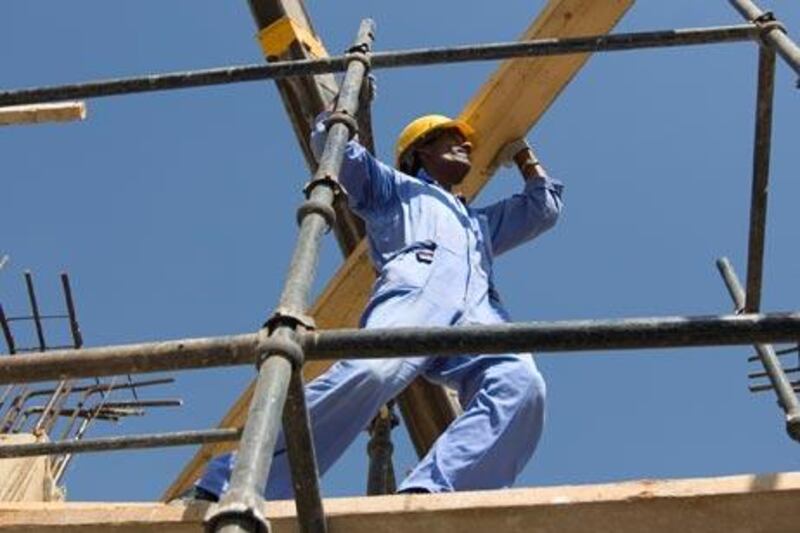ABU DHABI // Construction on buildings will start only if a comprehensive safety plan is in place, under rules to be introduced next week to protect workers.
Permits to begin work will be issued by Abu Dhabi Municipality only when measures to reduce industrial injuries and deaths have been approved. Inspectors from the municipality will visit sites to ensure the regulations are in place.
The policy, which comes into force next Sunday, is part of ongoing efforts to reduce further the number of accidents at construction areas across the city.
In 2009, at least 10 construction workers died in accidents in the UAE - four in falls, two in road accidents, one was struck by a falling object, one was the victim of a collapsed structure, one was killed by being trapped in machinery and one died handling materials.
A manual, which has been produced to outline the guidelines for health, safety and environmental standards for the construction sector, will help building professionals create plans for risk management and worker protection.
The manual includes guidance on developing preventative measures, including worker education and training, as well as standards for limiting the environmental impact of construction sites.
"Basically, the purpose of these guidelines is to help contractors and consultants to ensure that safety measures are implemented on the ground," said Abdul Aziz Zaarab, the director of the municipality's department of health, safety and environment. "The guidelines are very simple. They are put in place to guide and to ensure safety measures are in order to protect life."
Figures provided by BuildSafe UAE, a consortium of regional contractors and construction firms, and the only organisation in the area to analyse site safety statistics, showed that accidents and construction-related fatalities across the Emirates were on the decline in 2009.
Last year, 36 contractors covering 479 projects reported 530 lost-time incidents, which technically could range from broken bones to severed limbs. This number was down from 2008, when 18 contractors covering 388 projects reported 690 lost-time incidents and 20 fatalities. Numbers have not yet been collected for 2010.
However, the BuildSafe data was not comprehensive, since the figures were provided by the organisation's 67 signatory members and did not represent the entire industry. Numbers released by the Health Authority-Abu Dhabi last year put the fatality rate substantially higher, reporting 108 construction site deaths in 2009 in Abu Dhabi.
The health authority reported that 28 people died from falls, while 20 were hit by falling objects. Work-related road accidents killed 27 people and 13 were electrocuted.
According to BuildSafe, there were an average of 276,323 workers in the Emirates in 2009, though this number fell from 298,449 in January to 251,051 in December.
Mr Zaarab said a lack of consistent safety measures and the frequency of on-site accidents prompted the municipality to develop the manual.
"The construction industry has not been taking care of safety measures," he said.
The guidelines were developed over four months and will apply to 6,500 construction industry professionals. Inspectors will be responsible for ensuring that the municipality-approved safety plan is followed.
Guidelines include provisions on hazardous substances, noise, vibration, biological agents, dust, pests and radiation. The manual requires contractors, developers and construction firms to develop "control measures" for working at heights on scaffolds and ladders, excavation and trenches, demolition, electrical equipment and working over water.
The manual is a "crucial and positive step forward" but more can be done, said Jaana Quaintance, the associate for the Middle East and North Africa with Impactt Ltd, a labour standards consultancy.
"This approach, on face value, is quite compliance-focused," Ms Quaintance said. "Obviously that is the end goal - full compliance with law and no accidents - but health and safety is living and changing."
Too much focus on auditing could draw a company's resources away from implementing the health and safety standards on the ground, she said. A lack of provisions for worker training and communication could also prove to be problematic.
"It is frequently worker behaviour which both causes, and prevents, accidents," Ms Quaintance said. "There is a need to ensure that the quality, not just quantity, of training given to workers is improved, and that issues around literacy and language are addressed to ensure training is understood."





